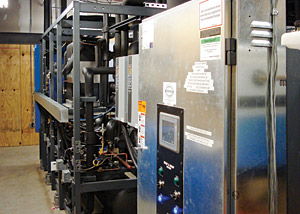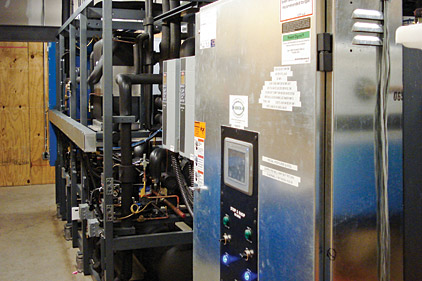
|
| Advances are being made worldwide in the use of CO2 as a refrigerant such as this application by Hill Phoenix at a supermarket in which the refrigerant is condensed by the medium temperature compressor system. |
No technology has been generating more attention in recent months than the use of R-744 (CO2) as a refrigerant. Throughout 2012, The NEWS and its exclusive refrigeration e-newsletter, FROSTlines, will publish reports and case histories on how R-744 is being used worldwide. Here are some of the latest announcements from a variety of sources.
Online Information
Danfoss has launched an online information portal that discusses CO2 as a refrigerant. It explains why the company considers CO2 among the most attractive refrigerants in industrial refrigeration and food retail applications and what kind of efficiency, safety, and environmental advantages can be achieved when using CO2 systems.
According to a report in the online publication R744.com, “There are a list of myths and assumptions as regards the use of CO2 as refrigerant that are only partly true or simply outdated. As a leading provider of solutions also for CO2 systems, Danish-based Danfoss has collected all these possibly misleading assumptions about CO2 to explain them in a comprehensible way. Myths such as the safety, efficiency, or costs of CO2 systems are discussed or overruled by case studies that prove the opposite.”
Heat Pumps
The South Korean companies Samsung and LG received government funding to develop CO2 heat pump water heaters. Samsung Electronics developed the prototype of the CO2 heat pump water heater, the Eco Cute, under the South Korean government’s project to support technological development of domestic companies. Samsung was subsequently chosen to develop medium- to large-size commercial CO2 heat pump water heaters, and LG Electronics was selected to develop smaller-sized residential units.
Transcritical in London
Harrods, the London department store, has installed a CO2 transcritical refrigeration system in its food hall. The existing HCFC-22 and HFC-404A refrigeration systems cooling the cold rooms and food cases have been replaced with a CO2 plant room using parallel compression technology. The plant room houses three HT/LT transcritical CO2 systems, each delivering 160 kW of cooling.
Transcritical Report
At the ATMOsphere Europe 2011 conference, Christoph Brouwers and Lothar Serwas from Carrier Commercial Refrigeration reported on the use of CO2 in direct expansion systems (DX).
They presented a case study from 2010 based on Carrier’s installation of approximately 150 stores with CO2OLtec™ transcritical systems in operation. These stores gained 18.5 MW of medium temperature refrigeration capacity. It was stated that the energy performance of these systems was mainly attractive at average annual temperatures of up to +15˚C.
Carrier also presented a study during the Chillventa 2010 Congress, maintaining that up to 19˚C, CO2 refrigeration systems would outperform other refrigerants. The same study concluded that CO2 systems would perform slightly better than other refrigerants between 20 and 26˚C.
In October 2011, Carrier put CO2OLtec TM direct expansion (DX) systems in some 300 stores. The systems offer 33 MW medium temperature refrigeration capacity with estimated emissions savings of 77,600 tons of CO2 equivalent emissions.
The report said, “Carrier is now working on overcoming the commonly referred to ‘CO2 equator’ which goes through Southern Europe along the northern shore of the Mediterranean, defining the efficiency limit CO2 systems compared to traditional HFC systems when assessed on a yearly average ambient temperature basis of maximum 15˚C.”
Oil Separator
The online publication R477.com reported that U.S.-based Temprite launched an addition to its 130 Series of coalescent oil separators for transcritical CO2 applications. The new 139A model is designed for high efficiency in larger R-744 refrigeration systems.
“The Temprite 130 Series is optimized for CO2 transcritical refrigeration applications and builds on the previous success of Temprite’s 920 and 920R Series coalescent oil separators, both extensively used in subcritical applications for many years,” the report said.
“The 130 Series utilizes the most efficient oil-refrigerant filtering/separation technology available. An efficient oil-gas separation technology becomes both more important and challenging when using CO2, as the refrigerant has a higher density than conventional refrigerants.
“Ambient outdoor temperature can also be troublesome for CO2 systems. Now, the manufacturer has developed the new 139A separator to bring maximum thermal efficiency especially to large CO2 refrigeration systems. With twice the separation capacity of the Model 137A, large-rack refrigeration users may find that one 139A will replace two 137A oil separators.”
Booster Compressor
In the Brazilian publication Engenharia e Arquitetura, Bitzer engineer Alessandro da Silva explained how working with very low evaporation temperatures multi-stage compression, such as in booster systems, can help to avoid high compression rates that can compromise compressor volumetric efficiency.
The report said, “The booster compressor is a single-stage compressor operating at the low-pressure stage of the cooling system with its discharge connected to the suction side of the high-pressure compressor. The two external pressure levels of the compressor system enable it to deliver refrigerated air to all refrigeration points in a system at the required temperatures. Booster systems can substantially reduce the rate of compression resulting in longer life of compressors and lower power consumption and are one of the most suitable systems for low temperatures. Booster systems can avoid some of the problems associated with single-stage compression systems.
“CO2 racks that include a booster system have compressor valve plates designed to ensure high rates of mass flow. The motors installed in the semi-hermetic CO2 compressors are larger than those in HCFC-22, HFC-404A, or HFC-507 systems, due to the need for greater capacity cooling.” However, the CO2 compressors are physically much smaller when compared with those for the previously mentioned f-gas systems.
Publication date: 02/6/2012



Report Abusive Comment